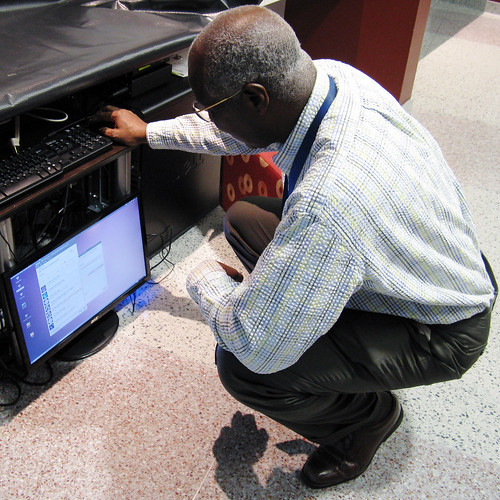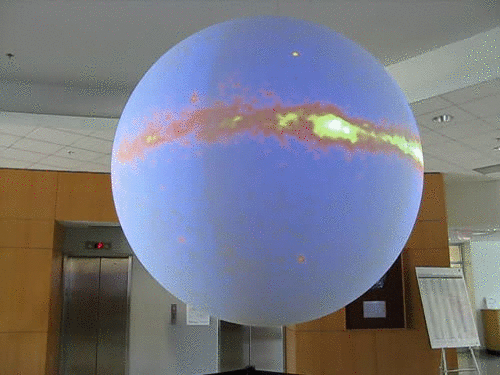Science on a Sphere
- By Maggie Masetti
- August 27, 2012
- 3 Comments
One of the things you can see if you visit NASA Goddard (or dozens of museums and other institutions worldwide) is a 68-inch sphere on which moving images are projected – it’s called “Science on a Sphere.” Goddard has one on display in its Visitor Center, and there’s also a traveling sphere that’s sometimes on display behind the gates in Building 34. Blueshift’s Sara Mitchell chatted with some of the Goddard folks who work with Science on a Sphere – Maurice Henderson, Britt Griswold, and Jay Friedlander – to find out how it came about, how it’s used, and what they are planning for the future.
Sara: What is Science on a Sphere?
Maurice Henderson: Science on a Sphere is a visualization platform that was developed by NOAA’s Forecast Systems Lab. Dr. Sandy MacDonald at OAR holds the patent for projecting earth science or spherical data sets onto a sphere-shaped movie screen. The software program allows us to drive four projectors – one at each corner of a square – and it gives the visualization effect of a ball in motion – Earth in motion, Sun in motion, planetary body in motion.
Sara: What is it used for?
Jay Friedlander: Well, as Maurice said it was developed by NOAA for displaying Earth science information, because NASA and NOAA together produce terabytes and terabytes of Earth science information every day. It’s a really easy way of showing how all the systems on the Earth work together. It’s a really amazing thing. Here at Goddard we do a lot of Earth science but we also do a lot of planetary and astrophysics type science with it (and heliophysics) so one of the things we’re tasked with is taking this thing that was developed for Earth science and applying all of the other sciences to it. We have lots of really nice image maps of the different planets, we can do that. Anything that’s spherical, we can do. The biggest challenge we’ve had is of course taking astrophysics data of the universe and putting that on a sphere, which is kind of counter-intuitive, so that’s definitely one of the things we’re working on. Britt and I put together “The Wanderers,” which is a tour of the solar system that starts at the Sun and goes out through the planets and stops at the asteroid belt and goes on out past what was a planet called Pluto which is now part of the Kuiper Belt. But basically anything that we could wrap around the sphere we wrapped around the sphere, starting at the Sun and working our way out.
Sara: How long has it been around?
Maurice: Science on a Sphere has been in the public domain since 2004. It came to the Visitor’s Center in 2005. So we were one of the first four commercial locations to deploy Science on a Sphere and we’ve been a principal supporter of the partnership between NASA and NOAA to bring Earth science and space science data sets to Science on a Sphere.
Sara: Where does Building 34’s traveling sphere go?
Maurice: It’s been to Geneva. It started the year in January; we went to Geneva, Switzerland for the world wide radio communications conference where Spectrum Management has negotiated with the ITU. We hosted it there for a month. It’s been to a few small museums since then. It’ll leave here at the end of the summer and go to the Glenn Research Center and possibly come back before the year is out.

Maurice Henderson operates the Science on a Sphere
Credit: Sara Mitchell
Sara: What sort of astrophysics content is currently available for the sphere?
Britt Griswold: The first thing we did was look at what NOAA had astrophysics-wise and Maurice has been contributing whatever he’s been able to snatch and put up on the NOAA site which is shared around the world. Precious little.
Sara: What astrophysics content are you hoping to create?
Jay: One of the things that a lot of our missions do, they’re called “all sky surveys.” COBE and WMAP and IRAS, different missions, have gone up and just as the Earth science missions orbit the Earth every 90 minutes and take pictures of the Earth going all the way around, these are in Earth orbit pointed the other way, pointing out into the universe, so as they orbit the Earth they basically map the entire sky. What you have is a sky map in the opposite and what we’ve done is taken that sky map in the opposite and mapped it onto the sphere. So if you look at what we call the “Multiwavelength Milky Way” and you look at the center of the image – it’s our Milky Way, the galaxy that we’re inside of – and all of the things that are around it galaxies, stars, nebulae, everything like that but in different wavelengths. So everywhere from X-ray to gamma ray… from large wavelengths to small wavelengths… we’re trying to get everywhere in between. So that’s the next big project we want to work on is a really nice presentation of the multiwavelength Milky Way sky.
Maurice: I believe the second set came in when Fermi, formerly the GLAST telescope, provided first year views and ultimately blazar animations and data over the life of Fermi. So we’ve been able to add those. And, as Jay said, we’ve had WISE bring infrared all sky maps of the Milky Way galaxy as well as optical maps we have for the Milky Way galaxy and now we’re able to display the multiwavelength Milky Way galaxy.
Britt: Right now those are data sets of basically pictures and short animations.

Britt Griswold compares the WMAP beach ball with a Science on a Sphere projection of the data
Credit: Sara Mitchell
Jay: Much like “The Wanderers” we want to have a tour of the multiwavelength sky. Many of the scientists look at one wavelength, so we want to be able to take the wavelengths they look at and show how it fits into the entire sky. The multiwavelength Milky Way used to be six different wavelengths and I think we’re up to fourteen. It just takes a mission that will take in an immense amount of data and the be able to visualize it. The Fermi one, it’s the gamma ray sky and gamma rays are small bursts, so how do you take small bursts and turn them into a sky map? Well, along with looking at the gamma ray bursts it looks at gamma ray emissions from stars and different parts of the galaxy. So they’ve actually mapped all the gamma ray emissions and that’s one that just came out in the spring. And then, as Maurice mentioned the new WISE infrared images just came out maybe three weeks ago. So this is all very recent, very current data.
Sara: So if someone wanted to go see one, how could they figure out where the closest Science on a Sphere is?
Maurice: The website sos.noaa.gov has a world map locating all of them and giving you contact and address information for all of the spheres.
Sara: And when you produce something it goes out to all the Science on a Spheres?
Maurice: NOAA hosts a repository and we put our content, like the full featured movies that Jay was talking about… there’s a category for those, as well as the individual data sets that are available. And not only Science on a Spheres but all of the spherical display systems that use that repository.
Jay: Michelle Thaller [Assistant Director for Science Communications in Goddard’s Sciences and Exploration Directorate] is really into doing sphere presentations and what she wants to start doing is take still images and the movies and putting together a 45 minute long presentation where she can talk about all different kinds of astronomy and earth science all together. So we’re going to be working real closely with her and trying to develop some new stuff for the sphere.
Britt: And one final project we’ve got on the boards is a five part series on life in extreme environments.
Jay: The extremeophiles and also astrobiology. Looking for life out in the solar system. It’s not only where to look for life but also what do we do know exists out there. We’re going to be working with some planetary scientists who are now into astrobiology very heavily and they’re going to help guide us on that presentation.
Sara: What does the Science on a Sphere offer that regular multimedia cannot?
Jay: The Sphere is a very strange thing because it’s not a screen. It’s not just a place just to show something on a solid object it’s an interactive thing. People need to get up, walk around it while the presentation is going on. You’re walking around the Earth and everything is there the clouds, the land masses, it’s moving, it’s just the coolest thing to actually interact with it. You have people who are used to making movies for sitting on a computer screen and all of a sudden they’ve got this sphere and they keep trying to make it into a movie screen – no, don’t do that. We want it to be the sphere. It is the sphere. So we want it to be interactive like that.

Animated GIF of Science on a Sphere (may take a few moments to load)
Credit: Sara Mitchell
If you live in the DC metro area, you can visit Science on a Sphere at the NASA Goddard Visitor Center (or the Smithsonian Museum of Natural History, the National Zoo, or the Maryland Science Center) – otherwise check out the NOAA Science on a Sphere site to locate the one nearest to you!




Guys, you are amazing! I wish I could work with you!
I visited NASA Goddard Visitor Center in August, on a Tuesday, and there were no lectures or model rocket launches. Is there somewhere schedule launches?
Helen – The Visitor Center maintains a calendar of events with their schedule. Most public events occur on the weekends. Hope that helps!